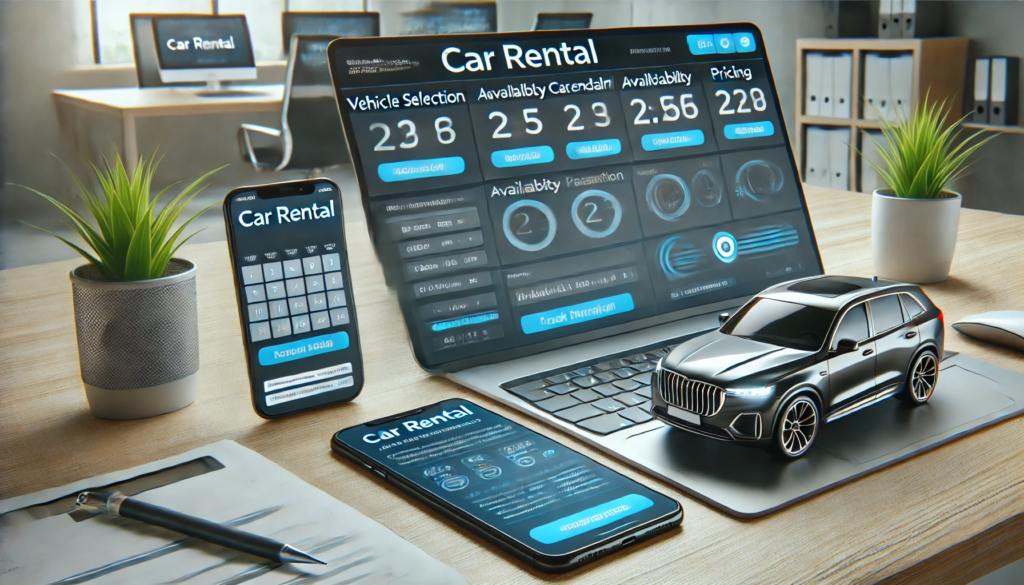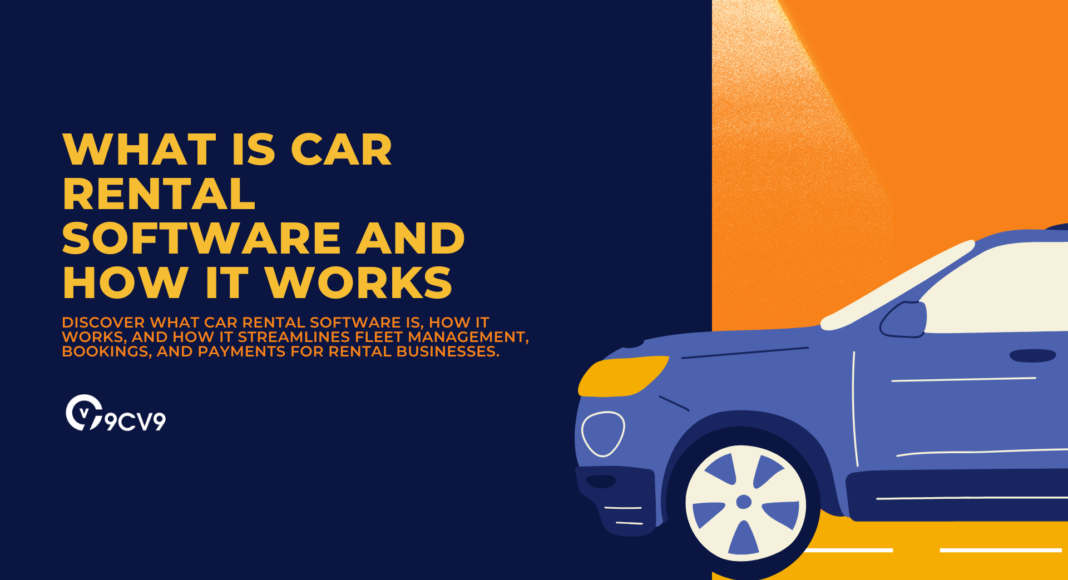Key Takeaways
- Car rental software automates fleet management, bookings, payments, and customer interactions, enhancing efficiency and reducing manual tasks.
- Advanced features like AI-driven pricing, real-time tracking, and digital contracts optimize operations and improve customer experiences.
- As the car rental industry evolves, adopting the right software is crucial for scalability, profitability, and staying competitive in a digital market.
The car rental industry has experienced significant transformations in recent years, driven by advancements in digital technology and changing consumer preferences.
With the increasing demand for flexible and convenient transportation solutions, car rental businesses are shifting towards automation to enhance operational efficiency, improve customer experience, and optimize fleet management.
This is where car rental software plays a crucial role.

Car rental software is an advanced digital solution designed to streamline every aspect of a rental business, from vehicle reservations and fleet tracking to customer management and payment processing.
Whether operating a small local rental service or a large-scale multinational fleet, businesses are adopting this technology to stay competitive in an evolving market.
By automating key processes, car rental software helps reduce human errors, minimize administrative tasks, and provide customers with a seamless booking experience.
The growing reliance on online platforms and mobile applications has also made digital car rental solutions more essential than ever.
Customers now expect real-time availability, instant booking confirmations, secure online payments, and hassle-free vehicle returns.
To meet these expectations, car rental companies are investing in software that integrates with their websites, mobile apps, and third-party platforms, ensuring a smooth and user-friendly experience.
Beyond enhancing customer interactions, car rental software offers robust fleet management capabilities, allowing rental businesses to monitor vehicle status, track mileage, schedule maintenance, and optimize pricing strategies based on demand.
Some advanced solutions even incorporate GPS tracking, automated invoicing, and AI-driven analytics, enabling companies to make data-driven decisions and maximize profitability.
With the increasing adoption of digital solutions, understanding what car rental software is, how it works, and why it is essential has become imperative for both established rental agencies and new entrants in the industry.
This blog explores the key functionalities, benefits, and working mechanisms of car rental software, providing valuable insights for businesses looking to leverage technology for improved efficiency and customer satisfaction.
Before we venture further into this article, we would like to share who we are and what we do.
About 9cv9
9cv9 is a business tech startup based in Singapore and Asia, with a strong presence all over the world.
With over nine years of startup and business experience, and being highly involved in connecting with thousands of companies and startups, the 9cv9 team has listed some important learning points in this overview of What is Car Rental Software and How It Works.
If your company needs recruitment and headhunting services to hire top-quality employees, you can use 9cv9 headhunting and recruitment services to hire top talents and candidates. Find out more here, or send over an email to [email protected].
Or just post 1 free job posting here at 9cv9 Hiring Portal in under 10 minutes.
What is Car Rental Software and How It Works
- What is Car Rental Software?
- Key Features of Car Rental Software
- How Does Car Rental Software Work?
- Benefits of Using Car Rental Software
- Challenges in Implementing Car Rental Software
- How to Choose the Right Car Rental Software
- Future Trends in Car Rental Software
1. What is Car Rental Software?
Car rental software is a specialized digital solution designed to help businesses manage their vehicle rental operations efficiently. It automates key processes such as fleet management, reservations, customer interactions, billing, and reporting. By integrating technology into the rental process, companies can reduce administrative workload, improve customer experience, and optimize overall operations.
This software is widely used by various businesses, including car rental agencies, ride-sharing services, corporate leasing firms, and peer-to-peer vehicle rental platforms. With features like online booking, real-time vehicle tracking, automated invoicing, and AI-powered analytics, car rental software enables companies to scale their operations while ensuring a smooth and hassle-free experience for customers.
Key Functions of Car Rental Software
1. Streamlining Online Bookings and Reservations
- Allows customers to browse available vehicles, check pricing, and make reservations through websites or mobile apps.
- Supports instant booking confirmations, reducing the need for manual processing.
- Provides real-time availability updates to prevent double bookings and ensure a seamless rental process.
- Example: Turo, a peer-to-peer car-sharing platform, uses rental software to facilitate online bookings, allowing users to rent vehicles from individual owners.
2. Efficient Fleet Management
- Enables rental businesses to monitor vehicle status, availability, and utilization.
- Tracks vehicle maintenance schedules to prevent unexpected breakdowns and ensure safety compliance.
- Helps businesses optimize fleet usage, ensuring that vehicles are rented out efficiently to maximize revenue.
- Example: Avis Car Rental uses fleet management software to track vehicle mileage, fuel consumption, and maintenance needs.
3. Customer Relationship Management (CRM)
- Stores customer data, rental history, and preferences for personalized service.
- Automates email and SMS notifications for booking confirmations, reminders, and special promotions.
- Helps businesses build customer loyalty through targeted marketing and rewards programs.
- Example: Enterprise Rent-A-Car integrates CRM features in its software to offer personalized discounts based on customer history.
4. Automated Billing and Payment Processing
- Generates digital invoices automatically, reducing manual errors and delays.
- Supports multiple payment methods, including credit/debit cards, e-wallets, and bank transfers.
- Integrates with payment gateways like PayPal, Stripe, and Square for secure transactions.
- Example: Hertz Car Rental offers an automated billing system where customers can pay online and receive digital invoices instantly.
5. GPS Tracking and Vehicle Security
- Provides real-time location tracking of rental vehicles to prevent theft and misuse.
- Uses geofencing technology to restrict vehicle movement within designated areas.
- Monitors driver behavior, such as speed limits and sudden braking, to enhance safety.
- Example: Zipcar uses GPS tracking to monitor vehicle locations and ensure compliance with rental agreements.
6. Dynamic Pricing and Discount Management
- Allows businesses to adjust rental prices based on demand, seasonality, and competitor pricing.
- Supports automated discount codes, promotional offers, and long-term rental packages.
- Helps maximize revenue by offering dynamic pricing strategies similar to airline ticket pricing models.
- Example: Sixt Rent a Car adjusts its rental rates dynamically based on real-time market conditions.
7. Mobile App Integration for On-the-Go Management
- Enables customers to book, modify, and cancel reservations through mobile applications.
- Provides digital check-in/check-out features to streamline vehicle pickup and return.
- Sends push notifications for reminders, promotions, and rental updates.
- Example: Getaround, a car-sharing service, offers a mobile app that allows users to unlock and start cars using their smartphones.
8. AI-Driven Analytics and Reporting
- Generates insights into customer preferences, booking trends, and fleet performance.
- Uses predictive analytics to optimize pricing, vehicle allocation, and maintenance scheduling.
- Helps businesses make data-driven decisions to improve efficiency and profitability.
- Example: U-Haul leverages AI-powered analytics to forecast demand and adjust inventory accordingly.
Who Uses Car Rental Software?
Car rental software is not limited to traditional rental agencies. Various businesses leverage this technology to enhance their operations:
1. Traditional Car Rental Companies
- Businesses like Hertz, Enterprise, and Budget use rental software to manage fleets across multiple locations.
- Helps in automating customer interactions, booking processes, and fleet optimization.
2. Peer-to-Peer (P2P) Car Sharing Platforms
- Companies like Turo and Getaround use software to connect car owners with renters.
- Features include online booking, insurance integration, and keyless vehicle access.
3. Corporate and Long-Term Leasing Firms
- Businesses offering corporate car rentals and leasing services use software for contract management and billing automation.
- Helps in fleet tracking, employee rental management, and automated invoicing.
- Example: LeasePlan, a global leasing company, uses software to manage corporate fleet rentals.
4. Ride-Sharing and Mobility-as-a-Service (MaaS) Companies
- Companies like Uber and Lyft integrate car rental software to manage vehicle fleets for drivers.
- Helps in vehicle allocation, maintenance tracking, and rental agreement management.
Why is Car Rental Software Important?
1. Enhances Operational Efficiency
- Reduces manual paperwork by automating bookings, payments, and vehicle tracking.
- Allows businesses to manage large fleets without increasing administrative overhead.
2. Improves Customer Experience
- Provides a seamless digital booking process with instant confirmations and real-time availability.
- Offers flexible rental options, including hourly, daily, and long-term rentals.
3. Increases Revenue and Profitability
- Optimizes fleet utilization to minimize idle vehicles and maximize rentals.
- Implements dynamic pricing strategies to increase revenue during peak demand.
4. Ensures Security and Compliance
- Tracks vehicle location, driver behavior, and rental agreements to prevent fraud.
- Helps businesses comply with local regulations by maintaining proper rental records.
Car rental software has revolutionized the industry by providing automation, efficiency, and enhanced customer experience. Whether running a traditional rental agency, a peer-to-peer car-sharing platform, or a corporate leasing firm, investing in the right car rental software can significantly improve operations and profitability.
2. Key Features of Car Rental Software
Car rental software is equipped with a wide range of features that help rental businesses manage their fleet, streamline bookings, automate customer interactions, and improve operational efficiency. These features are essential for providing a seamless experience to both rental companies and customers while ensuring security, compliance, and profitability.
1. Online Booking and Reservation Management
- Allows customers to browse available vehicles, compare prices, and make instant bookings via websites or mobile apps.
- Provides real-time availability updates to prevent double bookings and scheduling conflicts.
- Enables customers to modify or cancel reservations easily, reducing manual intervention.
- Example: Turo, a peer-to-peer car-sharing platform, offers a user-friendly online booking system where renters can choose cars based on location, price, and availability.
2. Fleet Management and Vehicle Tracking
- Monitors vehicle status, availability, and utilization to ensure optimal fleet performance.
- Tracks mileage, fuel consumption, and maintenance schedules to reduce wear and tear.
- Integrates with GPS tracking systems to monitor vehicle locations in real time.
- Helps businesses allocate vehicles efficiently, reducing downtime and maximizing rentals.
- Example: Avis Car Rental uses fleet management software to track vehicle movement, ensuring efficient allocation and maintenance.
3. Automated Billing and Payment Processing
- Generates invoices automatically, reducing manual billing errors and administrative workload.
- Supports multiple payment methods, including credit/debit cards, PayPal, Apple Pay, Google Pay, and bank transfers.
- Integrates with secure payment gateways like Stripe, Square, and PayPal to enable seamless transactions.
- Enables split payments, pre-authorized security deposits, and automatic refunds for cancellations.
- Example: Hertz Car Rental offers contactless payments and digital invoices to streamline the checkout process.
4. Customer Relationship Management (CRM) and User Profiles
- Stores customer details, rental history, preferences, and feedback for personalized service.
- Enables targeted promotions, discount offers, and loyalty programs based on customer history.
- Automates communication via email and SMS for booking confirmations, reminders, and promotions.
- Example: Enterprise Rent-A-Car uses CRM features to reward loyal customers with special discounts and perks.
5. Dynamic Pricing and Discount Management
- Adjusts rental prices based on demand, seasonality, and competitor pricing.
- Supports promotional campaigns, coupon codes, referral discounts, and long-term rental deals.
- Implements AI-driven pricing models to optimize revenue and increase profitability.
- Example: Sixt Rent a Car applies dynamic pricing strategies similar to airlines, adjusting rates in real time based on market conditions.
6. GPS Tracking and Geofencing
- Monitors vehicle location in real time to enhance security and prevent theft.
- Uses geofencing to restrict vehicle movement within predefined areas, reducing unauthorized trips.
- Alerts rental companies if a vehicle exits a designated zone or violates rental terms.
- Example: Zipcar incorporates GPS tracking in its rental software, allowing users to locate and unlock vehicles through their mobile app.
7. Mobile App Integration for Remote Management
- Allows customers to book, modify, and cancel reservations via mobile applications.
- Enables digital check-in/check-out, eliminating the need for physical paperwork.
- Provides push notifications for reservation updates, special offers, and vehicle status alerts.
- Example: Getaround offers a mobile app where users can locate, book, and unlock vehicles using their smartphones.
8. AI-Powered Analytics and Reporting
- Provides data-driven insights on booking trends, fleet performance, and revenue generation.
- Uses predictive analytics to forecast demand and optimize vehicle allocation.
- Helps businesses track key performance indicators (KPIs) such as revenue per vehicle, utilization rate, and customer retention.
- Example: U-Haul leverages AI-driven analytics to adjust pricing and inventory levels based on rental trends.
9. Multi-Location and Franchise Management
- Supports businesses operating in multiple locations, allowing centralized management of different rental branches.
- Enables franchise owners to monitor performance, pricing, and fleet distribution across various regions.
- Offers role-based access control to restrict data access for different user levels (e.g., admins, branch managers, and staff).
- Example: Budget Car Rental operates in multiple countries and uses rental software to manage pricing and fleet distribution across locations.
10. Digital Contracts and E-Signature Integration
- Enables customers to sign rental agreements digitally, reducing paperwork and processing time.
- Stores signed contracts securely in the system for easy access and compliance.
- Reduces disputes by ensuring customers agree to terms and conditions before vehicle pickup.
- Example: Hertz integrates digital contracts in its rental process, allowing customers to complete agreements via email before arrival.
11. Contactless Rental and Keyless Entry
- Supports self-service vehicle pickup and drop-off using mobile apps and smart locks.
- Allows customers to unlock and start cars without requiring a physical key, enhancing convenience.
- Reduces human interaction, making the rental process faster and safer.
- Example: Sixt Share offers keyless entry technology, enabling users to access rental vehicles with their smartphones.
12. Insurance and Compliance Management
- Automates the integration of rental insurance, ensuring coverage for damage, theft, and liability.
- Verifies driver licenses and ID documents before approving rentals.
- Ensures compliance with local rental regulations and policies.
- Example: Turo includes built-in insurance options, allowing both car owners and renters to choose appropriate coverage levels.
13. Maintenance and Service Scheduling
- Tracks vehicle maintenance history and schedules routine service appointments.
- Notifies rental businesses when cars need repairs, oil changes, or inspections.
- Reduces unexpected breakdowns by ensuring vehicles are always in optimal condition.
- Example: LeasePlan, a vehicle leasing company, uses software to automate service reminders for fleet maintenance.
14. Multi-Language and Multi-Currency Support
- Enables international rental businesses to offer services in multiple languages.
- Supports different currencies for seamless global transactions.
- Helps businesses expand into new markets without language or payment barriers.
- Example: Europcar provides multi-language and multi-currency support to cater to global customers.
15. Vehicle Damage Tracking and Inspection Reports
- Allows rental businesses to document vehicle conditions before and after rentals.
- Uses mobile apps to capture and store images of vehicle damages.
- Reduces disputes by ensuring transparency in the inspection process.
- Example: Avis integrates digital vehicle inspections in its rental software, helping document any pre-existing damage.
16. Integration with Third-Party Platforms
- Connects with travel agencies, airline booking systems, and hotel platforms to increase rental visibility.
- Integrates with accounting software like QuickBooks and Xero for automated financial management.
- Syncs with customer support tools like Zendesk and Salesforce for better service management.
- Example: Hertz partners with airlines and hotel booking platforms to provide bundled rental services.
17. AI Chatbots and Virtual Assistants
- Provides 24/7 customer support through AI-powered chatbots.
- Assists customers with booking queries, pricing details, and rental policies.
- Reduces response time and improves customer satisfaction.
- Example: Sixt Rent a Car uses AI chatbots to handle common customer inquiries and bookings.
18. Referral and Affiliate Program Management
- Enables businesses to track referrals and reward customers for recommending rental services.
- Automates affiliate commissions for travel agencies and partners.
- Helps businesses expand their customer base through word-of-mouth marketing.
- Example: Turo offers referral programs where both referrers and new users receive discounts on their next rental.
Car rental software is a comprehensive solution that enhances business efficiency, improves customer satisfaction, and increases profitability. With features ranging from online bookings and automated billing to AI-powered analytics and GPS tracking, rental companies can streamline their operations and stay competitive in the digital age.
3. How Does Car Rental Software Work?
Car rental software automates and streamlines every aspect of a rental business, from vehicle booking and fleet management to payment processing and customer interactions. It integrates advanced technologies such as cloud computing, artificial intelligence, and GPS tracking to ensure a seamless experience for both rental companies and customers.
1. Online Booking and Reservation Process
Car rental software simplifies the reservation process by allowing customers to book vehicles through websites or mobile apps.
- Vehicle Selection:
- Customers browse available vehicles based on category, pricing, features, and location.
- Filters allow users to refine search results based on car type (SUV, sedan, economy, luxury), transmission (automatic, manual), fuel type, and additional amenities.
- Example: Turo provides a detailed listing with vehicle photos, specifications, and customer reviews to help renters make informed decisions.
- Real-Time Availability Updates:
- The software syncs with the fleet database to display up-to-date availability.
- Prevents double bookings by blocking unavailable vehicles from appearing in search results.
- Instant or Scheduled Booking:
- Customers can choose between immediate rentals (on-demand) or future reservations.
- Some platforms offer hourly, daily, weekly, or monthly rental options.
- Booking Confirmation and Digital Invoicing:
- Once a customer confirms a booking, the system generates a digital invoice with rental details.
- An automated email or SMS notification is sent to confirm the reservation.
- Example: Hertz provides digital receipts that can be accessed via email or mobile apps.
2. Customer Registration and Verification
Before renting a vehicle, customers must complete an identity verification process to ensure security and compliance.
- User Account Creation:
- Customers create profiles with personal details, including name, contact information, and preferred payment methods.
- Returning users can log in to access past bookings and saved preferences.
- Driver’s License and Identity Verification:
- AI-powered tools scan and verify driver’s licenses, passports, or other identification documents.
- Some software solutions use biometric verification (facial recognition) to prevent fraud.
- Example: Getaround requires users to upload a valid driver’s license, which is verified before booking approval.
- Background Checks and Age Restrictions:
- The system checks for eligibility based on local laws (e.g., minimum age requirement).
- Rental companies can impose additional screening criteria, such as a clean driving history.
3. Fleet Management and Vehicle Assignment
Car rental software provides real-time fleet tracking and vehicle allocation to optimize operations.
- Automated Vehicle Assignment:
- The system assigns a vehicle based on availability, customer preference, and rental duration.
- Helps avoid overbooking and ensures fair distribution across rental locations.
- GPS Tracking and Live Monitoring:
- Integrated GPS systems track vehicle locations, ensuring security and monitoring unauthorized usage.
- Enables rental companies to locate lost or stolen vehicles instantly.
- Example: Zipcar allows users to locate their reserved vehicles using real-time GPS tracking.
- Geofencing for Rental Boundaries:
- Rental companies can set predefined geographic limits to prevent vehicles from being taken outside approved areas.
- Alerts are triggered if a vehicle exits the designated zone.
4. Digital Check-in and Contactless Vehicle Access
Modern car rental software supports keyless entry and digital check-in, eliminating the need for in-person interactions.
- Self-Service Kiosk or Mobile Check-in:
- Customers can check in using mobile apps or self-service kiosks at rental locations.
- Reduces waiting times and enhances user experience.
- Keyless Entry and Remote Unlocking:
- Vehicles equipped with IoT-enabled smart locks allow customers to unlock them using a mobile app.
- Ensures seamless pickup and drop-off without needing physical keys.
- Example: Sixt Share provides keyless car rentals through its mobile app.
5. Automated Billing and Payment Processing
Car rental software ensures seamless transactions by integrating with multiple payment gateways.
- Flexible Payment Methods:
- Supports credit/debit cards, PayPal, Apple Pay, Google Pay, and direct bank transfers.
- Allows customers to split payments among multiple users.
- Pre-Authorization of Security Deposits:
- Temporarily holds a deposit on the customer’s card to cover potential damages or late returns.
- Automatically releases the deposit after the vehicle is returned in good condition.
- Dynamic Pricing and Discounts:
- AI-driven pricing adjusts rental rates based on demand, availability, and market trends.
- Promotional codes and loyalty discounts can be applied at checkout.
- Example: Sixt Rent a Car uses demand-based pricing to adjust rental costs in real time.
- Automated Invoicing and Receipts:
- Generates and emails digital invoices instantly after the transaction is completed.
- Enables businesses to track revenue and financial reports in real time.
6. Vehicle Return and Inspection Process
Returning a rental car is a critical phase that involves inspections and damage assessments.
- Drop-off Location and Time Confirmation:
- Customers return the vehicle to the designated location as per the rental agreement.
- Some companies offer flexible drop-off points with location tracking.
- Automated Vehicle Inspection:
- AI-powered image recognition detects pre-existing and new damages.
- Customers can upload photos of the car via the mobile app before and after rental to avoid disputes.
- Example: Avis provides digital vehicle inspection reports to ensure transparency.
- Odometer and Fuel Level Tracking:
- The system records mileage and fuel levels to ensure compliance with rental terms.
- Customers may be charged for excess mileage or low fuel levels.
7. Insurance and Damage Claims Management
Rental software automates the insurance verification and claims process to ensure hassle-free settlements.
- Built-in Insurance Options:
- Customers can choose from different insurance packages for theft, collision, and liability coverage.
- Some software solutions integrate with third-party insurers for seamless claims processing.
- Damage Reporting and Claims Submission:
- Customers can report accidents or damages via the app, uploading supporting photos and documents.
- The system notifies rental managers to initiate claim settlements.
- Example: Turo offers built-in insurance protection plans and manages claims through its platform.
8. AI-Powered Analytics and Business Reporting
Car rental software provides valuable insights to optimize business performance.
- Revenue and Fleet Utilization Reports:
- Tracks rental trends, peak booking periods, and profitability metrics.
- AI-driven recommendations help maximize fleet efficiency.
- Customer Behavior Analytics:
- Identifies frequent renters, most popular vehicle models, and preferred rental durations.
- Helps businesses tailor marketing campaigns and customer incentives.
- Fraud Detection and Risk Management:
- AI-driven risk assessment tools detect fraudulent transactions and unauthorized bookings.
- Example: Uber Rent integrates AI-powered fraud detection to prevent misuse of rental services.
9. Integration with Third-Party Platforms
Car rental software connects with external services to expand functionality and improve efficiency.
- Travel and Hospitality Platforms:
- Integrates with airline and hotel booking systems to offer bundled services.
- Example: Hertz partners with airlines to provide discounted rentals for frequent flyers.
- Accounting and Tax Compliance Tools:
- Syncs with accounting software like QuickBooks to automate financial tracking.
- Ensures tax compliance with built-in VAT/GST calculations.
- Customer Support and Chatbots:
- AI chatbots handle customer inquiries, cancellations, and refund requests in real time.
- Example: Sixt uses AI-driven chatbots for customer support and FAQs.
Car rental software simplifies operations, improves customer experience, and enhances security through automation and AI-driven features. By integrating booking management, fleet tracking, digital check-in, and automated billing, rental businesses can optimize efficiency and boost profitability while ensuring a smooth rental process for customers.
4. Benefits of Using Car Rental Software
Car rental software has transformed the vehicle rental industry by automating business operations, enhancing customer experiences, and maximizing efficiency. Whether for small rental businesses or large enterprises, these digital solutions offer various advantages, including real-time fleet tracking, automated billing, and AI-driven analytics.
1. Streamlined Booking and Reservation Process
Car rental software eliminates manual booking processes and ensures a smooth reservation experience for customers.
- 24/7 Online Booking Access:
- Customers can book vehicles anytime through a website or mobile app without visiting a rental office.
- Example: Turo and Zipcar allow users to reserve cars remotely, even outside business hours.
- Real-Time Availability Updates:
- Displays up-to-date inventory to prevent double bookings and rental conflicts.
- Ensures that only available vehicles appear in customer search results.
- Automated Booking Confirmation and Notifications:
- Instantly sends email or SMS notifications to confirm reservations.
- Reduces the risk of miscommunication between rental companies and customers.
- Flexible Rental Duration Options:
- Offers hourly, daily, weekly, or monthly rental periods.
- Example: Sixt provides short-term and long-term rental options, catering to different customer needs.
2. Improved Fleet Management and Utilization
Car rental software helps businesses monitor and optimize vehicle usage, reducing downtime and increasing profitability.
- Real-Time Fleet Tracking with GPS Integration:
- Enables rental companies to track vehicle locations and monitor unauthorized movements.
- Example: Hertz uses GPS tracking to manage its fleet across multiple locations.
- Automated Vehicle Assignment:
- Assigns vehicles based on availability, rental history, and customer preferences.
- Ensures balanced usage across the entire fleet to prevent excessive wear and tear on specific cars.
- Predictive Maintenance Scheduling:
- Tracks mileage and wear to schedule timely maintenance and repairs.
- Prevents breakdowns and ensures vehicles remain in top condition.
- Example: Enterprise Rent-A-Car uses predictive maintenance to reduce unexpected vehicle downtime.
- Fuel and Mileage Monitoring:
- Keeps track of fuel levels and mileage, ensuring accurate billing and operational efficiency.
3. Enhanced Customer Experience
By offering user-friendly booking options and efficient support, car rental software improves overall customer satisfaction.
- Seamless Digital Check-In and Check-Out:
- Allows customers to check in via mobile apps and unlock vehicles without visiting a rental counter.
- Example: Zipcar provides keyless access, enabling users to start their rental without physical interaction.
- Multiple Payment Options and Secure Transactions:
- Supports credit/debit cards, PayPal, Apple Pay, Google Pay, and cryptocurrency payments.
- Uses encryption and fraud detection tools to protect customer data.
- Loyalty Programs and Personalized Offers:
- Tracks customer preferences and offers personalized discounts or rewards for repeat bookings.
- Example: Avis Preferred rewards program provides discounts and upgrades for loyal customers.
- Multilingual Support for Global Users:
- Enables international customers to book vehicles in their preferred language.
- Helps businesses expand their customer base beyond local markets.
4. Increased Revenue and Business Growth
Car rental software optimizes pricing strategies and enhances revenue generation.
- Dynamic Pricing Based on Demand:
- AI-driven algorithms adjust rental prices based on demand, location, and availability.
- Helps businesses maximize profits during peak seasons.
- Example: Sixt Rent a Car uses dynamic pricing to adjust rates in real time.
- Upselling and Cross-Selling Opportunities:
- Recommends additional services such as insurance, GPS, child seats, or extended rental periods.
- Increases average order value without manual intervention.
- Automated Billing and Digital Invoicing:
- Generates invoices instantly, reducing administrative workload.
- Allows customers to review billing details and download receipts easily.
- Fraud Prevention and Secure Payments:
- Integrates with AI-powered fraud detection systems to prevent chargebacks and unauthorized bookings.
- Example: Uber Rent uses AI-based fraud prevention to secure transactions.
5. Cost Reduction and Operational Efficiency
Car rental software helps companies reduce costs by automating key processes and optimizing fleet usage.
- Reduced Administrative Workload:
- Eliminates the need for manual paperwork, freeing up employees for higher-value tasks.
- Example: Enterprise Rent-A-Car automates contract management and billing, reducing labor costs.
- Minimized Fuel and Maintenance Expenses:
- Ensures vehicles are rented efficiently, reducing idle time and unnecessary expenses.
- Uses predictive analytics to prevent costly repairs.
- Lowered Overhead Costs:
- Eliminates the need for large rental offices by enabling remote and self-service rentals.
- Example: Sixt Share operates with minimal physical locations, reducing operational costs.
6. Better Compliance and Legal Management
Automated rental software ensures businesses adhere to legal and regulatory requirements.
- Driver’s License and Identity Verification:
- Uses AI-driven document scanning to verify customer credentials instantly.
- Prevents fraud and ensures only eligible drivers rent vehicles.
- Integrated Insurance Management:
- Allows businesses to offer built-in insurance packages, reducing liability risks.
- Example: Turo offers tiered insurance plans to cover rental damages.
- Automated Tax Calculations and Compliance Reports:
- Generates tax reports based on rental locations and applicable laws.
- Ensures businesses meet financial reporting requirements.
7. AI-Powered Analytics and Business Insights
Data-driven insights help rental businesses make informed decisions and improve operations.
- Fleet Utilization Reports:
- Tracks vehicle usage trends and identifies underutilized assets.
- Helps businesses optimize fleet sizes based on demand.
- Customer Behavior Analytics:
- Identifies peak booking times, popular vehicle types, and customer preferences.
- Example: Hertz uses data analytics to adjust fleet inventory based on demand.
- Revenue and Profitability Tracking:
- Generates detailed financial reports, allowing businesses to monitor revenue growth.
- Helps companies adjust pricing strategies to maximize earnings.
8. Seamless Integration with Third-Party Services
Car rental software enhances its functionality by integrating with external tools and platforms.
- Accounting and ERP System Integration:
- Syncs with QuickBooks, Xero, and other accounting software for automated financial tracking.
- Hotel and Travel Industry Partnerships:
- Connects with airlines and travel booking platforms for bundled rental services.
- Example: Hertz partners with Delta Airlines to offer discounts for frequent flyers.
- Customer Support and AI Chatbots:
- Uses AI-driven chatbots to handle inquiries, cancellations, and refunds.
- Example: Sixt employs an AI chatbot for real-time customer support.
Car rental software transforms the vehicle rental business by increasing efficiency, reducing costs, and enhancing customer experiences. With features such as automated booking, dynamic pricing, AI-powered analytics, and fraud prevention, rental companies can maximize profitability and improve fleet management while offering a seamless experience for renters.
5. Challenges in Implementing Car Rental Software
While car rental software offers numerous advantages, businesses often face several challenges during its implementation. These challenges can stem from technical issues, user adoption barriers, integration difficulties, and regulatory compliance. Understanding these obstacles can help businesses develop effective strategies to mitigate risks and optimize their car rental software solutions.
1. High Initial Investment and Implementation Costs
Setting up a car rental software system requires a significant upfront investment in software licenses, hardware, and system integration.
- Software Subscription or Licensing Fees:
- Many advanced car rental software solutions operate on monthly or annual subscription models, which may be costly for startups or small businesses.
- Example: SaaS-based platforms like Rent Centric or HQ Rental Software charge based on the number of users, vehicles, and features included.
- Hardware and Infrastructure Requirements:
- Businesses may need to upgrade their existing IT infrastructure to support the new software.
- Additional hardware, such as GPS tracking devices, keyless entry systems, and payment terminals, may be required.
- Customization and Development Costs:
- Off-the-shelf software may not meet all business requirements, necessitating customization and third-party integrations.
- Custom development can be costly and time-consuming.
2. Integration Issues with Existing Systems
Car rental businesses often rely on multiple software solutions for fleet management, accounting, customer relationship management (CRM), and payment processing. Integrating new car rental software with existing systems can be challenging.
- Data Synchronization Challenges:
- Inconsistent data flow between platforms can cause booking errors, duplicate records, and incorrect inventory tracking.
- Example: A rental company using QuickBooks for accounting and RentGuruz for fleet management may face difficulties syncing financial and rental transaction data.
- API Compatibility Issues:
- Not all car rental software solutions provide seamless API integrations with third-party services.
- Businesses may need custom API development, increasing costs and implementation time.
- Difficulty in Integrating with Payment Gateways:
- Some rental businesses face challenges in integrating local payment gateways due to regional banking restrictions or security compliance issues.
- Example: A company in Southeast Asia may struggle to integrate Alipay or GrabPay if the software primarily supports Western payment methods.
3. Employee Resistance to New Technology
Employees accustomed to traditional rental processes may resist adopting new digital systems, fearing complexity or job displacement.
- Lack of Digital Literacy:
- Some employees may struggle with learning cloud-based booking and fleet management systems, especially in companies that previously relied on manual processes.
- Training programs are required to help employees transition smoothly.
- Fear of Job Redundancy:
- Automation of tasks such as invoicing, fleet allocation, and customer inquiries may create concerns about job security.
- Businesses should reassure employees that software enhances efficiency rather than replacing jobs.
- Resistance to Change in Workflows:
- Employees accustomed to traditional phone-based bookings and paper-based contracts may resist digital solutions.
- Example: In small local car rental businesses, staff may prefer face-to-face interactions rather than automated self-service kiosks.
4. Cybersecurity and Data Protection Risks
Car rental businesses handle sensitive customer information, including personal details, payment data, and driving license records. Securing this data against cyber threats is a major concern.
- Risk of Data Breaches and Hacking Attempts:
- Cybercriminals target car rental companies to steal customer payment information.
- Example: In 2021, a major car rental company suffered a data breach that exposed thousands of customer records.
- Compliance with Data Protection Regulations:
- Businesses must adhere to GDPR (Europe), CCPA (California), and other regional data privacy laws.
- Failure to comply can lead to heavy fines and reputational damage.
- Lack of Security Awareness Among Employees:
- Employees may unknowingly fall victim to phishing attacks or use weak passwords, leading to security vulnerabilities.
- Regular cybersecurity training and multi-factor authentication (MFA) can help prevent breaches.
5. Poor User Experience and Technical Glitches
If car rental software is not user-friendly, mobile-responsive, or free from bugs, it can create frustration for customers and employees.
- Complex User Interfaces:
- If the software has a cluttered dashboard or difficult navigation, employees may struggle to perform tasks efficiently.
- Example: A customer using an outdated mobile app may face errors during the booking process, leading to abandoned reservations.
- Slow System Performance and Downtime:
- Unoptimized software can experience slow load times, server crashes, or unexpected downtime, impacting business operations.
- Example: If a car rental company’s online booking portal goes offline, customers may switch to competitors.
- Limited Mobile Compatibility:
- Customers expect to book, modify, and manage rentals via mobile apps.
- Lack of mobile-responsive design can lead to poor customer retention rates.
6. Regulatory and Legal Compliance Challenges
Car rental businesses must adhere to local, national, and international vehicle rental laws. Compliance requirements vary depending on geographical location, insurance policies, and licensing regulations.
- Vehicle Insurance and Liability Compliance:
- Rental companies must ensure that all vehicles meet insurance requirements, including liability coverage for accidents.
- Example: In the U.S., car rental companies must comply with state-specific insurance laws that vary by jurisdiction.
- Driver’s License Verification and Fraud Prevention:
- Some software lacks robust identity verification features, making it vulnerable to fraudulent rentals.
- Example: A rental company without AI-powered license scanning may unknowingly rent to unlicensed drivers.
- Taxation and Accounting Regulations:
- Businesses must calculate and report rental taxes accurately, especially when operating in multiple states or countries.
- Example: A car rental company operating in New York and Florida may face different tax compliance requirements for each state.
7. Limited Scalability for Growing Businesses
Some car rental software solutions are not designed to scale as businesses expand their fleet, services, and locations.
- Difficulty in Managing Multiple Branches:
- Rental companies expanding to new locations may struggle with centralized fleet and booking management.
- Example: A business with multiple branches in Europe and Asia may require multi-location software with localized currency support.
- Inability to Handle High Booking Volumes:
- Basic software solutions may not support large volumes of simultaneous bookings, leading to system crashes during peak seasons.
- Example: A rental company during holiday seasons may experience software lag if the platform cannot process multiple transactions efficiently.
- Lack of Customization for Business-Specific Needs:
- Some car rental software solutions offer limited flexibility in modifying pricing, insurance policies, and rental terms.
- Businesses may need expensive add-ons or third-party solutions for customization.
8. Customer Service and Support Limitations
Even with advanced software, poor customer support from software providers can hinder business operations.
- Slow Response Time from Software Vendors:
- Some providers lack 24/7 customer support, delaying issue resolution.
- Example: If a system crash occurs on a weekend, the rental company may have to wait until business hours for assistance.
- Lack of Training Resources and Documentation:
- Some software companies provide minimal training materials, leaving employees to figure out the system on their own.
- Businesses should prioritize software providers with extensive training resources and onboarding support.
- High Costs for Premium Support Services:
- Some vendors charge extra for priority support and troubleshooting, increasing long-term costs.
- Example: Enterprise-level rental software providers may charge high fees for dedicated technical support.
Car rental businesses must carefully evaluate these challenges before implementing car rental software. Choosing a scalable, secure, and well-supported solution while investing in employee training and cybersecurity can help businesses overcome these obstacles and maximize the benefits of digital transformation.
6. How to Choose the Right Car Rental Software
Selecting the right car rental software is essential for streamlining business operations, enhancing customer experience, and ensuring long-term growth. With numerous options available, businesses must consider key factors such as functionality, scalability, integration capabilities, security, and cost-effectiveness. This guide outlines the critical aspects to evaluate when choosing the best car rental software.
1. Identify Your Business Needs and Goals
Before selecting a car rental software, businesses must assess their specific requirements based on their size, operations, and customer base.
- Business Model Considerations:
- Do you operate a short-term or long-term rental business?
- Are you offering self-drive rentals, chauffeur-driven services, or corporate leasing?
- Example: A company specializing in luxury car rentals will require different features than a budget-friendly car-sharing service.
- Fleet Size and Management Needs:
- Ensure the software can efficiently handle your current fleet size and future growth.
- Some solutions cater to small rental businesses, while others are built for large enterprises managing hundreds of vehicles.
- Example: Rent Centric and Navotar offer fleet tracking for businesses with a high volume of vehicles.
- Target Customer Base and Booking Methods:
- Do you cater to walk-in customers, online bookings, or corporate clients?
- Choose software with features that align with your customer preferences.
- Example: A business catering to tourists should prioritize online and mobile booking features, while a corporate rental service may require invoicing and long-term contract management.
2. Look for Essential Features and Functionalities
Car rental software should offer comprehensive features that improve operational efficiency and customer satisfaction.
- Reservation and Booking Management:
- An intuitive booking system with real-time availability updates is essential.
- Example: HQ Rental Software offers automated booking confirmations and digital contracts to speed up the rental process.
- Fleet Management and Vehicle Tracking:
- The software should support GPS tracking, vehicle maintenance alerts, and fuel consumption monitoring.
- Example: Easy Rent Pro provides detailed fleet utilization reports, helping businesses maximize vehicle usage.
- Automated Billing and Payment Processing:
- Look for integration with multiple payment gateways (PayPal, Stripe, credit cards, etc.).
- Automated invoicing and secure online payments improve financial management.
- Example: RentSyst integrates with accounting software like QuickBooks for seamless financial tracking.
- Customer Relationship Management (CRM):
- A built-in CRM helps track customer interactions, rental history, and loyalty programs.
- Example: Limo Anywhere provides customer feedback tracking and marketing automation tools to boost retention.
- Multi-Location and Multi-Currency Support:
- If your business operates in multiple cities or countries, ensure the software supports localized pricing, currencies, and tax calculations.
- Example: Bookinglayer offers multi-currency pricing and international tax compliance features.
3. Evaluate Integration Capabilities
Seamless integration with existing tools and third-party services ensures smooth business operations.
- Accounting and Financial Software Integration:
- Integration with QuickBooks, Xero, or Sage simplifies financial reporting and bookkeeping.
- Example: Zoho Books integration in some rental platforms allows for real-time revenue tracking.
- GPS and Telematics System Compatibility:
- Ensure the software can connect with GPS tracking systems for vehicle monitoring and theft prevention.
- Example: Samsara and Geotab GPS integrations provide detailed insights into vehicle location and driver behavior.
- Marketing and Customer Support Tools:
- Integration with email marketing platforms (Mailchimp, HubSpot) and chat support (Zendesk, LiveChat) enhances customer engagement.
- Example: SimplyBook.me integrates with WhatsApp Business for instant customer communication.
4. Assess User Experience and Accessibility
The software should be easy to use for both employees and customers.
- User-Friendly Dashboard and Navigation:
- Employees should be able to quickly access booking details, fleet status, and customer data without extensive training.
- Example: RentWorks offers a drag-and-drop interface for managing reservations.
- Mobile App Availability and Responsiveness:
- A mobile-friendly platform enables customers to book rentals on the go.
- Example: Turo and Getaround offer fully functional mobile apps for self-service bookings.
- Multi-Language Support:
- If catering to international customers, ensure the platform supports multiple languages.
- Example: CarPro Systems offers multi-language booking portals for a global audience.
5. Prioritize Security and Compliance
Security and regulatory compliance are critical in handling sensitive customer information and financial transactions.
- Data Encryption and Cybersecurity Measures:
- The software should offer SSL encryption, secure login (2FA), and fraud detection mechanisms.
- Example: RentGuruz ensures PCI-DSS compliance for secure credit card transactions.
- Compliance with Regional Data Protection Laws:
- Ensure the software adheres to GDPR (Europe), CCPA (California), or other local privacy laws.
- Example: A rental company in Europe must use GDPR-compliant software to handle customer data legally.
- Driver Verification and Fraud Prevention:
- Features like AI-powered ID verification and automated background checks enhance security.
- Example: SnapCar and Getaround use AI-based license verification to prevent fraudulent rentals.
6. Compare Pricing and Total Cost of Ownership
Car rental software pricing varies based on subscription models, features, and scalability options.
- Monthly Subscription vs. One-Time Licensing:
- SaaS-based solutions require monthly or yearly payments, while some offer one-time purchase options.
- Example: HQ Rental Software offers both SaaS and self-hosted solutions.
- Additional Costs for Customization and Support:
- Some providers charge extra for custom features, API access, or premium customer support.
- Example: Navotar offers custom development at an additional cost.
- Scalability Considerations:
- Choose a solution that allows business growth without excessive upgrade costs.
- Example: MyRent offers tiered pricing plans based on fleet size.
7. Check Customer Reviews and Software Reputation
Before finalizing a decision, research customer feedback and industry ratings.
- Read Online Reviews and Case Studies:
- Platforms like Capterra, G2, and Trustpilot provide insights into real user experiences.
- Example: A rental business choosing between Rent Centric and Easy Rent Pro can compare ratings on Capterra.
- Request a Free Trial or Demo:
- Most software providers offer free trials or live demos to test features before purchasing.
- Example: Limo Anywhere provides a 14-day free trial to explore its capabilities.
- Evaluate Customer Support Responsiveness:
- Ensure the provider offers 24/7 customer support, documentation, and training resources.
- Example: RentSyst provides dedicated account managers for enterprise clients.
Final Thoughts
Choosing the right car rental software requires thorough evaluation based on business needs, essential features, integration capabilities, security, cost, and user experience. Investing in the right platform can significantly enhance operational efficiency, improve customer satisfaction, and drive business growth. Conducting detailed comparisons and leveraging free trials can help businesses make an informed decision.
7. Future Trends in Car Rental Software
As the car rental industry continues to evolve, technology plays a significant role in shaping its future. Advancements in AI, IoT, blockchain, and automation are driving innovation, enhancing customer experiences, and improving operational efficiency. The following are key trends that will shape the future of car rental software in the coming years.
1. AI-Powered Automation for Enhanced Operations
Artificial Intelligence (AI) is transforming the car rental industry by automating workflows, improving customer service, and optimizing fleet management.
- AI-Driven Chatbots and Virtual Assistants:
- AI-powered chatbots handle customer inquiries, booking modifications, and rental support in real time.
- Example: Avis and Hertz use AI chatbots to assist customers with rental queries 24/7.
- Automated Pricing Optimization:
- AI algorithms analyze demand, seasonal trends, and competitor pricing to automatically adjust rental rates.
- Example: RateGain and PriceLabs offer AI-driven dynamic pricing tools to maximize revenue.
- Smart Fleet Management with Predictive Maintenance:
- AI can predict vehicle maintenance needs based on usage patterns and diagnostics, reducing downtime.
- Example: Fleet Complete provides AI-powered maintenance alerts for car rental companies.
2. Internet of Things (IoT) and Connected Vehicles
IoT integration is revolutionizing fleet management by enabling real-time vehicle tracking, remote diagnostics, and smart locks.
- GPS-Based Live Vehicle Tracking:
- IoT-enabled car rental software allows real-time tracking of vehicle locations, routes, and status updates.
- Example: Geotab and Samsara offer live GPS tracking with geofencing capabilities.
- Remote Vehicle Access and Keyless Entry:
- Customers can unlock and start rental cars using mobile apps or RFID technology, eliminating the need for physical keys.
- Example: Zipcar and Getaround provide smart lock access via mobile apps.
- Advanced Driver Monitoring and Telematics:
- IoT sensors track driving behavior, fuel consumption, and accident reports to improve fleet safety.
- Example: Telematics systems like Verizon Connect provide real-time driver analytics.
3. Blockchain Technology for Secure Transactions
Blockchain technology enhances security, transparency, and efficiency in car rental transactions and fleet management.
- Decentralized Rental Agreements and Smart Contracts:
- Blockchain-based smart contracts automate rental agreements, reducing paperwork and fraud risks.
- Example: HireGo, a blockchain-based car-sharing platform, ensures tamper-proof agreements.
- Secure Payment Processing with Cryptocurrency Integration:
- Some platforms now accept Bitcoin, Ethereum, and other cryptocurrencies for rental payments.
- Example: Travel companies like CheapAir accept crypto payments, signaling future adoption in car rentals.
- Enhanced Identity Verification:
- Blockchain ensures secure and tamper-proof identity verification, reducing fraudulent rentals.
- Example: SelfKey and uPort provide blockchain-based digital identity solutions.
4. Rise of Subscription-Based and Long-Term Rentals
The demand for car subscription services and long-term rentals is increasing as consumers seek flexibility over ownership.
- Monthly Car Subscription Services:
- Customers prefer fixed monthly rental plans with maintenance and insurance included.
- Example: Sixt+ and Fair offer car subscription models with no long-term commitments.
- Corporate and Fleet Leasing Solutions:
- Businesses opt for long-term leasing packages instead of buying company vehicles.
- Example: LeasePlan and Enterprise Fleet Management provide scalable leasing solutions.
5. Integration with Mobility-as-a-Service (MaaS) Platforms
Car rental software is evolving to integrate with public transportation, ride-sharing, and multi-modal travel platforms.
- Seamless Multi-Modal Bookings:
- Customers can book rental cars alongside buses, trains, and ride-hailing services in a single app.
- Example: Uber Rent integrates rental cars into its mobility app, allowing users to switch between transport modes.
- Smart City and Sustainable Transportation Initiatives:
- Governments and companies are collaborating on smart city car rental solutions that reduce congestion.
- Example: Singapore’s OneMobility platform integrates car rentals with public transport networks.
6. Electric Vehicle (EV) Rentals and Sustainable Mobility
The shift towards sustainable transportation and eco-friendly vehicles is shaping the car rental industry’s future.
- Growing Demand for EV Rentals:
- Rental companies are adding electric and hybrid vehicles to their fleets due to rising environmental concerns.
- Example: Hertz partnered with Tesla to introduce a large EV rental fleet.
- EV Charging Station Mapping and Booking:
- Car rental software integrates real-time EV charging station locators for customer convenience.
- Example: EVgo and ChargePoint apps help users find charging stations for rental EVs.
- Carbon Offset Programs for Rental Customers:
- Some rental companies offer carbon offset options, allowing users to contribute to sustainability initiatives.
- Example: Green Motion and Europcar provide carbon offset rental plans.
7. Cloud-Based Car Rental Software for Scalability
Cloud computing is transforming car rental management by offering scalable, flexible, and remote-accessible solutions.
- Remote Access and Multi-Location Management:
- Businesses can manage multiple rental locations from a single cloud-based dashboard.
- Example: HQ Rental Software provides cloud-based rental management for global businesses.
- Seamless Software Updates and Customization:
- Cloud platforms allow automatic updates and software enhancements without manual intervention.
- Example: Navotar and Rent Centric offer customizable cloud-based rental software.
- Scalable Solutions for Small and Large Businesses:
- Startups and enterprises can expand operations without infrastructure limitations.
- Example: RentSyst provides scalable cloud-based solutions for businesses of all sizes.
8. Big Data and Analytics for Better Decision-Making
Data analytics is driving smarter business decisions in car rental operations.
- Customer Behavior and Demand Forecasting:
- AI-driven analytics predict rental demand based on seasonality, location, and customer behavior.
- Example: Revionics and RateGain provide predictive analytics for rental pricing.
- Fleet Utilization and Efficiency Optimization:
- Businesses use data insights to maximize vehicle utilization and reduce idle time.
- Example: Fleet Complete analytics tools track vehicle usage patterns.
- Personalized Marketing and Loyalty Programs:
- AI-driven insights help rental companies offer personalized discounts and promotions.
- Example: Sixt and Enterprise use big data for loyalty program optimization.
Final Thoughts
The future of car rental software is driven by AI automation, IoT connectivity, blockchain security, and sustainable mobility. As customer preferences evolve, rental companies must adopt tech-driven solutions to remain competitive. Investing in cloud-based, AI-powered, and data-driven software will be crucial for businesses looking to scale operations and enhance customer experiences in the rapidly changing mobility landscape.
Conclusion
Car rental software has become an essential tool for modern car rental businesses, enabling them to streamline operations, enhance customer experiences, and maximize profitability. As the industry evolves, technology plays a crucial role in transforming traditional car rental processes into highly efficient, automated, and data-driven solutions.
From automated booking systems and AI-powered fleet management to IoT-enabled vehicle tracking and blockchain-secured transactions, car rental software is reshaping the way rental companies operate. These advanced capabilities not only improve efficiency but also provide greater convenience and transparency for both businesses and customers. With features such as dynamic pricing, predictive maintenance, digital contracts, and integrated payment gateways, rental companies can optimize their resources, reduce operational costs, and offer seamless rental experiences.
The Growing Demand for Car Rental Software
As the global mobility landscape shifts towards on-demand transportation and shared mobility solutions, the demand for sophisticated car rental software continues to grow. Several factors contribute to this increasing demand:
- Rising Popularity of Car-Sharing and Subscription Services – Consumers now seek flexible and cost-effective alternatives to car ownership, leading to a surge in rental services.
- Advancements in AI, IoT, and Cloud Technology – Car rental software is becoming smarter, more scalable, and data-driven, allowing businesses to make informed decisions in real-time.
- Customer Expectations for Convenience and Digitalization – With the rise of mobile-first experiences, renters expect a hassle-free, paperless, and self-service rental process.
- Sustainability and the Shift Towards Electric Vehicles (EVs) – More rental companies are integrating EV fleets, carbon offset programs, and eco-friendly rental options to align with environmental trends.
Key Benefits Driving the Adoption of Car Rental Software
Companies that leverage car rental software can unlock a range of business benefits, including:
- Increased Operational Efficiency – Automating manual processes such as reservations, fleet tracking, and invoicing significantly reduces administrative burdens.
- Enhanced Customer Experience – Providing instant bookings, digital contracts, and self-service kiosksimproves customer satisfaction and loyalty.
- Better Fleet Utilization and Cost Savings – AI-powered analytics help rental companies optimize vehicle usage, fuel consumption, and maintenance schedules.
- Scalability and Business Growth – Cloud-based solutions enable rental businesses to expand to new locations and manage multi-city operations with ease.
- Higher Revenue and Profitability – With dynamic pricing strategies, upselling features, and loyalty programs, companies can maximize their revenue potential.
Future Outlook: What Lies Ahead for Car Rental Software?
The future of car rental software is shaped by technological advancements, evolving customer demands, and mobility trends. In the coming years, we can expect:
- AI-Powered Predictive Analytics – Smarter algorithms will forecast demand, predict vehicle wear and tear, and optimize pricing models.
- Blockchain-Based Digital Agreements – Secure, automated contracts will eliminate paperwork and reduce fraud risks.
- Autonomous and Connected Vehicle Integration – Self-driving car rentals will soon become a reality, and car rental software will need to adapt to manage autonomous fleets.
- Deeper Integration with Mobility-as-a-Service (MaaS) – Rental services will be seamlessly connected with public transport, ride-sharing, and smart city initiatives.
Final Thoughts
Investing in the right car rental software is no longer optional—it is a necessity for businesses aiming to stay competitive in an increasingly digital and data-driven industry. Whether a small rental agency or a global fleet management company, adopting an advanced software solution can streamline operations, improve customer engagement, and drive long-term profitability.
As innovation continues to shape the future of car rentals, businesses must embrace emerging trends, sustainable mobility solutions, and AI-driven automation to remain ahead of the curve. By integrating cutting-edge car rental software, companies can enhance efficiency, optimize costs, and deliver a superior rental experience in an ever-evolving market.
If you find this article useful, why not share it with your hiring manager and C-level suite friends and also leave a nice comment below?
We, at the 9cv9 Research Team, strive to bring the latest and most meaningful data, guides, and statistics to your doorstep.
To get access to top-quality guides, click over to 9cv9 Blog.
People Also Ask
What is car rental software?
Car rental software is a digital solution that automates booking, fleet management, customer interactions, and payment processing for car rental businesses.
How does car rental software work?
It streamlines operations by managing reservations, tracking vehicles, automating pricing, and integrating with payment gateways for seamless transactions.
What are the key features of car rental software?
Features include online booking, fleet tracking, automated invoicing, customer management, AI-powered pricing, and digital contracts.
Who can benefit from car rental software?
Car rental companies, ride-sharing businesses, leasing firms, and even dealerships offering rental services can benefit from it.
Can car rental software integrate with payment gateways?
Yes, most car rental software supports integration with payment gateways like PayPal, Stripe, and credit card processors for secure transactions.
Does car rental software support multi-location businesses?
Yes, advanced solutions allow businesses to manage multiple rental locations, track fleet availability, and handle bookings centrally.
Is car rental software cloud-based?
Many modern solutions are cloud-based, enabling businesses to access data and manage operations remotely from any device.
Can customers book rentals online using car rental software?
Yes, most software includes an online booking system that lets customers reserve vehicles through a website or mobile app.
How does car rental software help with fleet management?
It provides real-time tracking, maintenance alerts, and usage reports to optimize fleet performance and reduce operational costs.
Can car rental software automate pricing and discounts?
Yes, AI-driven pricing models adjust rates based on demand, seasonality, and availability, while automated discount features attract more customers.
Is car rental software secure?
Reputable car rental software includes security measures such as data encryption, secure payments, and user authentication protocols.
How does car rental software improve customer experience?
It simplifies booking, provides instant confirmations, enables self-service options, and ensures faster check-ins and check-outs.
Does car rental software support different vehicle types?
Yes, it can manage various vehicle categories, including cars, motorcycles, vans, and luxury fleets.
Can car rental software generate invoices automatically?
Yes, it automates invoicing, generates receipts, and tracks payments to improve financial accuracy and reduce manual work.
Is car rental software mobile-friendly?
Most solutions offer mobile compatibility or dedicated apps for both customers and business owners.
Does car rental software include GPS tracking?
Many platforms integrate with GPS tracking to monitor vehicle locations, prevent theft, and ensure compliance with rental agreements.
How does car rental software handle damages and maintenance?
It records vehicle conditions before and after rental, schedules maintenance, and alerts managers about required repairs.
Can car rental software manage rental agreements digitally?
Yes, many solutions offer e-signature and digital contract features to streamline agreement processing.
Is car rental software suitable for small businesses?
Yes, there are scalable solutions designed to fit the needs and budgets of small and mid-sized car rental businesses.
Can car rental software integrate with third-party tools?
Yes, many platforms support integrations with CRM, accounting software, and marketing tools for a seamless workflow.
How does car rental software prevent double bookings?
It provides real-time availability updates, ensuring that vehicles are not double-booked or overbooked.
Does car rental software offer multilingual support?
Some platforms include multi-language support to cater to international customers.
Can car rental software automate driver and staff management?
Yes, it helps assign vehicles to drivers, track schedules, and manage employee roles efficiently.
How does AI enhance car rental software?
AI automates pricing, predicts customer demand, and optimizes fleet utilization based on historical data.
Is car rental software customizable?
Many solutions allow customization of pricing, branding, rental policies, and additional service offerings.
Can car rental software send automated notifications?
Yes, it can send booking confirmations, payment reminders, and maintenance alerts via email or SMS.
How does car rental software improve business efficiency?
It reduces manual work, automates administrative tasks, and provides data-driven insights to enhance decision-making.
What are the common challenges of using car rental software?
Challenges include software integration issues, training staff, and ensuring a smooth transition from manual processes.
How do I choose the best car rental software?
Consider factors such as ease of use, scalability, integration capabilities, pricing, customer support, and security features.
What is the future of car rental software?
Future trends include AI-driven automation, blockchain-based contracts, electric vehicle management, and enhanced mobile accessibility.































![Writing A Good CV [6 Tips To Improve Your CV] 6 Tips To Improve Your CV](https://blog.9cv9.com/wp-content/uploads/2020/06/2020-06-02-2-100x70.png)


